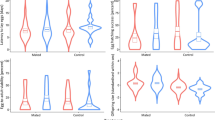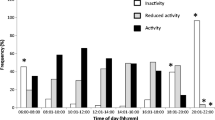Abstract
Mating trophallaxis represents a fascinating strategy adopted by males of several animal species to affect the decision-making of females during mating. Among tephritids, few species perform mating trophallaxis. However, this phenomenon has been little studied in major tephritid pests. We reported the presence of indirect mating trophallaxis in Mediterranean fruit flies, Ceratitis capitata, showing its influence on the main mating traits, male mating success and female egg load. Of 219 mating pairs, only 27 of them showed mating trophallaxis, indicating that mating trophallaxis may represent a significant male energy investment. The duration of male wing vibration and the whole precopula phase was longer in pairs that mated without trophallaxis compared to the pairs displaying mating trophallaxis. Males that displayed trophallaxis performed a longer whole duration of the courtship and mating sequence, with no differences in copula duration. Male mating success was slightly increased by trophallaxis. The majority of males performing trophallaxis skipped wing vibration during courtship, while all males courting females without trophallaxis relied on wing vibration to attract females within short distances. No egg load differences were reported for females that consumed nuptial gifts over control females. Overall, our research sheds light on the relation between indirect mating trophallaxis and egg load production in medflies, providing a better understanding of sexual selective mechanisms as the basis of courtship and mating behaviour in tephritid flies. Furthermore, this behaviour could be used as a quality control parameter to assess medfly mass-reared strains, in order to improve sterile insect technique programmes.



Similar content being viewed by others
References
Alcock J (1989) Animal behavior. Sinauer Associates, Sunderland
Aluja M, Norrbom A (2000) Fruit flies (Tephritidae): phylogeny and evolution of behavior. CRC Press, Boca Raton
Aluja M, Jàcome I, Birke A, Lozada N, Quintero G (1993) Basic patterns of behaviour in wild Anastrepha striata (Diptera: Tephritidae). Appl Entomol Zool 19:42–51
ASAB/ABS (2014) Guidelines for the treatment of animals in behavioural research and teaching. Anim Behav 99:1–9
Benelli G (2015) Should I fight or should I flight? How studying insect aggression can help integrated pest management. Pest Manag Sci 71:885–892
Benelli G, Canale A, Bonsignori G, Ragni G, Stefanini C, Raspi A (2012) Male wing vibration in the mating behavior of the olive fruit fly Bactrocera oleae (Rossi) (Diptera: Tephritidae). J Insect Behav 25:590–603
Benelli G, Daane KM, Canale A, Niu CY, Messing RH, Vargas RI (2014) Sexual communication and related behaviours in Tephritidae: current knowledge and potential applications for integrated pest management. J Pest Sci 87(3):385–405
Benelli G, Romano D, Desneux N, Messing RH, Canale A (2015a) Sex differences in fighting-induced hyperaggression in a fly. Anim Behav 104:165–174
Benelli G, Desneux N, Romano D, Conte G, Messing RH, Canale A (2015b) Contest experience enhances aggressive behaviour in a fly: when losers learn to win. Sci Rep 5:9347
Benelli G, Romano D, Messing RH, Canale A (2015c) Population-level lateralized aggressive and courtship displays make better fighters not lovers: evidence from a fly. Behav Process 115:163–168
Benelli G, Romano D, Stefanini C, Kavallieratos NG, Athanassiou CG, Canale A (2017) Asymmetry of mating behaviour affects copulation success in two stored-product beetles. J Pest Sci 90:547–556
Briceño RD, Eberhard WG (2002) Courtship in the medfly, Ceratitis capitata, includes tactile stimulation with the male’s aristae. Entomol Exp Appl 102(3):221–228
Briceño D, Ramos D, Eberhard W (1996) Courtship behaviour of male Ceratitis capitata (Diptera: Tephritidae) in captivity. Fla Entomol 79:130–143
Canale A, Gennari G, Leoni V, Messing RH, Benelli G (2015) Impact of a long-lasting adult liquid diet on female reproductive performance in the Mediterranean fruit fly, Ceratitis capitata (Diptera: Tephritidae). J Asia Pac Entomol 18(2):263–265
Carey JR, Papadopoulos N, Kouloussis N, Katsoyannos B, Müller HG, Wang JL, Tseng YK (2006) Age-specific and lifetime behavior patterns in Drosophila melanogaster and the Mediterranean fruit fly, Ceratitis capitata. Exp Gerontol 41(1):93–97
Carpita A, Canale A, Raffaelli A, Saba A, Benelli G, Raspi A (2012) (Z)-9-tricosene identified in rectal gland extracts of Bactrocera oleae males: first evidence of a male-produced female attractant in olive fruit fly. Naturwissenschaften 99:77–81
Darwin C (1871) The descent of man, and selection in relation to sex, vol 1. Murray, London
Donati E, Worm M, van der Wiel M, Mintchev S, Benelli G, von der Emde G, Stefanini C (2016) Investigation of collective behaviour and electrocommunication in the weakly electric fish, Mormyrus rume, through a biomimetic robotic dummy fish. Bioinspir Biomimet 11(6):066009
Drew RAI, Lloyd AC (1987) Relationship of fruit flies (Diptera: Tephritidae) and their bacteria to host plants. Ann Entomol Soc Am 80(5):629–636
European Commission (2007) Commission recommendations of 18 June 2007 on guidelines for the accommodation and care of animals used for experimental and other scientific purposes. Annex II to European Council Directive 86/609. See 2007/526/EC http://eurex.europa.eu/LexUriServ/LexUriServ.do?uri¼OJ:L:2007:197:0001:0089:EN:PDF
Foote BA (1967) Biology and immature stages of fruit flies: the genus Icterica (Diptera, Tephritidae). Ann Entomol Soc Am 60:1295–1305
Freidberg A (1978) Reproductive behaviour of fruit flies. Ph.D. dissertation, Tel Aviv University, Tel Aviv
Freidberg A (1981) Mating behaviour of Schistopterum moebiusi Becker (Diptera: Tephritidae). Isr J Entomol 15:89–95
Freidberg A (1982) Courtship and post-mating behaviour of the fleabane gall fly, Spathulina tristis (Diptera: Tephritidae). Entomol Gen 7:273–285
Freidberg A (1984) The mating behavior of Asteia elegantula with biological notes on some other Asteiidae (Diptera). Entomol Gen 9:217–224
Freidberg A (1997) Mating trophallaxis in Metasphenisca negeviana (Freidberg) (Diptera: Tephritidae). Isr J Entomol 31:199–203
Given BB (1953) Evolutionary trends in the Thynninae (Hymenoptera: Tiphiidae) with special reference to feeding habits of Australian species. Trans R Entomol Soc Lond 105:1–10
Goeden RD, Headrick DH (1992) Life history and description of immature stages of Neaspilota viridescens Quisenberry (Diptera: Tephritidae) on native Asteraceae in southern California. Proc Entomol Soc Wash 94:59–77
Headrick DH, Goeden RD (1990) Life history of Paracantha gentilis (Diptera: Tephritidae). Ann Entomol Soc Am 83:776–785
Hendrichs J, Cooley SS, Prokopy RJ (1992) Post-feeding bubbling behaviour in fluid-feeding Diptera: concentration of crop contents by oral evaporation of excess water. Physiol Entomol 17(2):153–161
Immonen E, Hoikkala A, Kazem AJ, Ritchie MG (2009) When are vomiting males attractive? Sexual selection on condition-dependent nuptial feeding in Drosophila subobscura. Behav Ecol 20(2):289–295
Jenkis J (1990) Mating behaviour of Aciurina mexicana (Aczel) (Diptera: Tephritidae). Proc Entomol Soc Wash 92:66–75
Kirkendall LR (1983) The evolution of mating systems in bark and ambrosia beetles (Coleoptera: Scolytidae and Platypodidae). Zool J Linn Soc 77:293–352
Lewis SM, Vahed K, Koene JM, Engqvist L, Bussière LF, Perry JC, Gwynne D, Lehmann GUC (2014) Emerging issues in the evolution of animal nuptial gifts. Biol Lett 10:20140336
Miranda X (2000) Sexual dimorphism in the aristae of Ceratitis capitata (Diptera, Tephritidae) and its possible importance in courtship. J N Y Entomol Soc 108:339–348
Ngo TD, Schioler H (2007) Randomized robot trophallaxis: from concept to implementation. In: 2007, IEEE Sys Man Cybern, pp 208–213
Novak JA, Foote BA (1975) Biology and immature stages of fruit flies: the genus Stenopa (Diptera, Tephritidae). J Kans Entomol Soc 48:42–52
Paiero SM, Marshall SA (2014) Indirect trophalaxis and courtship behaviour in the Nothybidae. J Insect Behav 27(6):712
Papadopoulos NT, Liedo P, Müller HG, Wang JL, Molleman F, Carey JR (2010) Cost of reproduction in male medflies: the primacy of sexual courting in extreme longevity reduction. J Insect Physiol 56(3):283–287
Perez-Staples D, Aluja M (2004) Anastrepha striata (Diptera: Tephritidae) females that mate with virgin males live longer. Ann Entomol Soc Am 97(6):1336–1341
Romano D, Donati E, Canale A, Messing RH, Benelli G, Stefanini C (2016a) Lateralized courtship in a parasitic wasp. Laterality 21(3):243–254
Romano D, Kavallieratos NG, Athanassiou CG, Stefanini C, Canale A, Benelli G (2016b) Impact of geographical origin and rearing medium on mating success and lateralization in the rice weevil, Sitophilus oryzae (L.) (Coleoptera: Curculionidae). J Stor Prod Res 69:106–112
Schmickl T, Crailsheim K (2008) Trophallaxis within a robotic swarm: bio-inspired communication among robots in a swarm. Auton Robot 25(1–2):171–188
Shelly TE (2000) Male signalling and lek attractiveness in the Mediterranean fruit fly. Anim Behav 60:245–251
Sivinski J, Aluja M, Dodson G, Freidberg A, Headrick D, Kaneshiro K, Landolt P (2000) Topics in the evolution of sexual behavior in the Tephritidae. In: Aluja M, Norrbom AL (eds) Fruit flies (Tephritidae): phylogeny and evolution of behavior. CRC Press, Boca Raton, pp 751–792
Steck GL (1984) Chaetostomella undosa (Diptera: Tephritidae): biology, ecology, and larval description. Ann Entomol Soc Am 77:669–678
Stoffolano JG Jr, Haselton AT (2013) The adult Dipteran crop: a unique and overlooked organ. Annu Rev Entomol 58:205–225
Stoltzfus WB, Foote BE (1965) The use of froth masses in courtship of Euretra (Diptera: Tephritidae). Proc Entomol Soc Wash 67:263–264
Thornhill R (1976) Sexual selection and nuptial feeding behaviour in Bittacus apicalis (Insecta: Mecoptera). Am Nat 110:529–548
Vahed K (1998) The function of nuptial feeding in insects: a review of empirical studies. Biol Rev 73(1):43–78
Wedell N (1994) Variation in nuptial gift quality in bush crickets (Orthoptera: Tettigoniidae). Behav Ecol 5:418–425
Acknowledgements
Two anonymous reviewers kindly improved an earlier version of this manuscript. The authors would like to thank Prof. A. Canale for helpful discussions on the topic, as well as Dr. A. Loni for technical assistance in medfly rearing.
Funding
G. Benelli is sponsored by PROAPI (PRAF 2015) and University of Pisa, Department of Agriculture, Food and Environment (Grant ID: COFIN2015_22). This work was supported by the H2020 Project “Submarine cultures perform long-term robotic exploration of unconventional environmental niches” (subCULTron) [640967FP7]. Funders had no role in the study design, data collection and analysis, decision to publish or preparation of the manuscript.
Author information
Authors and Affiliations
Corresponding author
Ethics declarations
Animals and human rights
All applicable international and national guidelines for the care and use of animals were followed. All procedures performed in studies involving animals were in accordance with the ethical standards of the institution or practice at which the studies were conducted.
Additional information
Communicated by M. Traugott.
Rights and permissions
About this article
Cite this article
Benelli, G., Romano, D. Does indirect mating trophallaxis boost male mating success and female egg load in Mediterranean fruit flies?. J Pest Sci 91, 181–188 (2018). https://doi.org/10.1007/s10340-017-0854-z
Received:
Revised:
Accepted:
Published:
Issue Date:
DOI: https://doi.org/10.1007/s10340-017-0854-z




